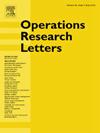无连续休息时间循环赛的休息时间最大化
IF 0.9
4区 管理学
Q4 OPERATIONS RESEARCH & MANAGEMENT SCIENCE
引用次数: 0
摘要
在体育比赛的赛程安排中,尤其是循环赛,一个重要的目标就是制定公平的比赛日程表。我们的重点是制定平衡主客场比赛场次的赛程表,以确保公平性,同时最大限度地增加连续主场比赛和连续客场比赛的场次,即间歇期。本文确定了间歇期场次的上限,并证明这些上限在多达 36 支球队时都很严格。本文章由计算机程序翻译,如有差异,请以英文原文为准。
Break maximization for round-robin tournaments without consecutive breaks
In sports scheduling, particularly for round-robin tournaments, an important objective is to create equitable game schedules. Our focus is on developing schedules that balance the number of home and away games to ensure fairness, while also maximizing the number of consecutive home games and consecutive away games, referred to as breaks. This paper establishes upper bounds for the number of breaks and demonstrates that these bounds are tight for up to 36 teams.
求助全文
通过发布文献求助,成功后即可免费获取论文全文。
去求助
来源期刊

Operations Research Letters
管理科学-运筹学与管理科学
CiteScore
2.10
自引率
9.10%
发文量
111
审稿时长
83 days
期刊介绍:
Operations Research Letters is committed to the rapid review and fast publication of short articles on all aspects of operations research and analytics. Apart from a limitation to eight journal pages, quality, originality, relevance and clarity are the only criteria for selecting the papers to be published. ORL covers the broad field of optimization, stochastic models and game theory. Specific areas of interest include networks, routing, location, queueing, scheduling, inventory, reliability, and financial engineering. We wish to explore interfaces with other fields such as life sciences and health care, artificial intelligence and machine learning, energy distribution, and computational social sciences and humanities. Our traditional strength is in methodology, including theory, modelling, algorithms and computational studies. We also welcome novel applications and concise literature reviews.
 求助内容:
求助内容: 应助结果提醒方式:
应助结果提醒方式:


